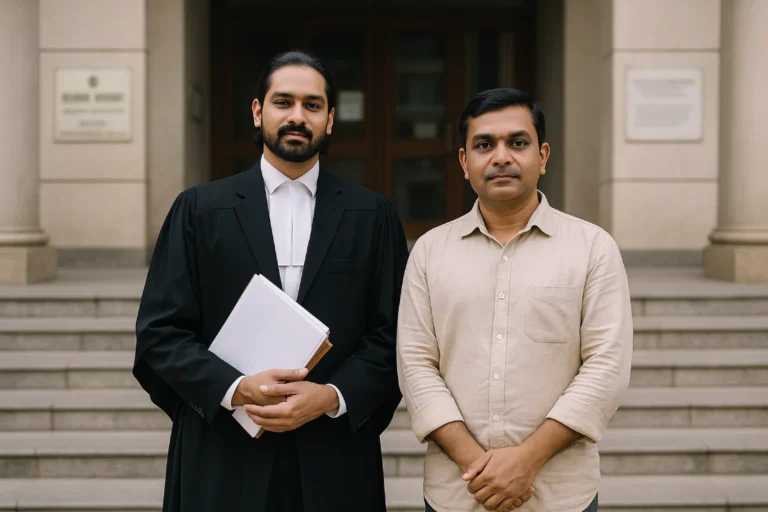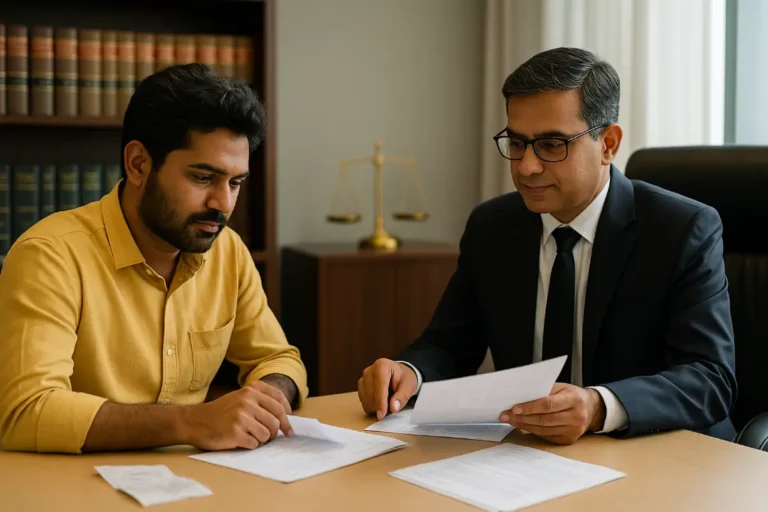Mutual Consent vs Contested Divorce: What It Really Means
For readers comparing options, the Differences Between Mutual Consent and Contested Divorce are simple: agreement vs proof.
Mutual Consent vs Contested Divorce is about agreement. If both spouses agree to end the marriage and settle alimony, child custody, and property, a mutual consent divorce is faster, simpler, and less stressful. If one spouse disputes the end of the marriage or the terms, it becomes a contested divorce that needs evidence, witnesses, and a full trial.
Short tip: If settlement is possible, choose mutual consent. If key issues are disputed or safety is a concern, go contested.
Mutual Consent vs Contested Divorce in Indian Law
Mutual consent divorce exists across major personal laws: Section 13B of the Hindu Marriage Act (HMA), Section 28 of the Special Marriage Act (SMA), Section 10A of the Indian Divorce Act (Christians), and Section 32B of the Parsi Marriage and Divorce Act. Each requires joint filing and free consent.
Contested divorce is a regular lawsuit based on legally recognised grounds such as cruelty, adultery, desertion, conversion, or mental disorder, under Section 13 of the HMA and similar provisions in other laws.
In 2017, the Supreme Court held that courts may waive the six‑month cooling‑off period in mutual consent cases when reconciliation is not possible and settlements are complete (Amardeep Singh v. Harveen Kaur). In 2023, a Constitution Bench confirmed that the Supreme Court can dissolve a marriage for irretrievable breakdown under Article 142, a power that lower courts do not have (Shilpa Sailesh v. Varun Sreenivasan).
Compare agreement, evidence, timeline, cost, stress, and control so you can choose the path that fits your situation.
Summary table – Mutual Consent vs Contested Divorce
| Aspect | Mutual consent | Contested |
| Agreement | Both agree to the divorce terms | One alleges a ground; the other disputes |
| Evidence | Minimal; focus on consent and settlement | Documents, witnesses, cross‑examination |
| Time | 6‑month wait (often waivable), then decree | Longer due to trial stages |
| Control | Parties design the terms | The judge decides after hearing |
| Stress | Lower conflict | Higher conflict |
This quick table highlights the core Differences Between Mutual Consent and Contested Divorce in day‑to‑day terms.
- Trigger
- Mutual consent: Both spouses jointly seek divorce.
- Contested: One spouse alleges a legal ground; the other disputes it.
- Proof
- Mutual consent: No fault‑finding. The court checks free consent and fairness.
- Contested: Evidence, witnesses, and cross‑examination are common.
- Time
- Mutual consent: First motion → 6‑month cooling‑off (often waivable) → second motion → decree.
- Contested: Pleadings, mediation, interim orders, evidence, arguments, judgment.
- Control
- Mutual consent: You shape terms-alimony, custody, property, future claims.
- Contested: Judge decides after trial.
- Stress & privacy
- Mutual consent: Fewer hearings, lower conflict.
- Contested: More hearings, public record of allegations.
For a city‑specific walkthrough, see our divorce process in Bangalore guide.
When should you choose mutual consent?

Pick mutual consent if you and your spouse can settle on the four pillars:
- Alimony/maintenance (lump sum or monthly).
- Child custody and visitation (clear parenting plan).
- Property and debts (who keeps what; how to close loans).
- Future claims (both waive further claims except what is recorded).
When these are settled, Mutual Consent vs Contested Divorce becomes a clear choice: mutual consent wins on time, cost, and emotional toll.
Not sure about fault‑based grounds if talks break down? Read our overview of grounds for divorce in India.
When does a case need to be contested?
Choose a contested path if:
- Your spouse refuses divorce or demands unfair terms.
- You need firm judicial findings (e.g., cruelty) and protective relief.
- There are serious disputes on custody, residence, or property.
- You require interim maintenance or injunctions during the case.
For the courtroom roadmap, see: What is a contested divorce.
Procedure Snapshots for Mutual Consent vs Contested Divorce
See the key steps in both routes-what happens in court, documents to carry, and decisions you’ll make along the way.

Mutual consent divorce – the simple path
- Separation: Typically, at least one year of living separately (HMA 13B(1) / SMA 28; personal‑law variations apply).
- First motion: Joint petition with a full, written settlement.
- Cooling‑off: Six months; family courts may seek a waiver when the criteria from Amardeep Singh are met.
- Second motion & decree: Both spouses confirm consent; decree of divorce is granted.
Good to know: Only the Supreme Court can use Article 142 to grant a decree by dissolving a marriage directly in exceptional cases.
Contested divorce – the full trial
- Petition & response → 2. Mediation → 3. Interim orders (maintenance, custody, protection) → 4. Evidence & cross‑examination → 5. Final hearing & decree.
Can you switch paths mid‑way?
If you started with a contested case but later settled, the best practice is to withdraw the contested case and file a fresh joint petition under Section 13B. Courts have clarified that you generally cannot “convert” separate contested petitions into a mutual‑consent case; you must take the proper 13B route.
Uncontested Divorce vs Contested Divorce – are they the same as mutual consent?

In everyday speech, “uncontested divorce” means the other spouse does not object. The phrase Uncontested Divorce vs Contested Divorce often appears in searches, and it maps closely to mutual consent vs contested options in India. In India, the formal route for an uncontested end to marriage is mutual consent divorce under your personal law (HMA 13B / SMA 28 / Indian Divorce Act 10A / Parsi Act 32B). If any core term is disputed, it is a contested divorce-that is, the real line between Uncontested Divorce vs Contested Divorce.
A quick decision tool
Use this quick checklist to choose between mutual consent and contested divorce based on agreement, disputes, and children’s needs.
- You both agree on the end and the terms? Choose mutual consent.
- You disagree on the end or key terms? Prepare for a contested divorce and gather evidence.
- Children involved? Courts favour clear, child‑centric plans. For guidance, see our Hindu child custody laws.
Mistakes to avoid
Avoid common pitfalls that can delay your case or weaken your settlement.
- Using consent as leverage: Consent must be free; pressure can derail the decree.
- Vague settlements: Write complete terms-alimony, custody, property, future claims.
- Missing documents: Keep proofs of separation, income, assets, expenses, and child costs.
- Assuming the 6‑month wait is fixed: Ask about a waiver based on Amardeep Singh.
- Ignoring tax and loan closure steps: Plan payouts, account transfers, and closures in writing.
FAQs
What is the difference between mutual consent and contested divorce?
Mutual consent is cooperative. Both spouses agree to end the marriage and settle terms. The court checks free consent and fairness. Contested divorce is adversarial. One spouse alleges a legal ground and must prove it. The judge decides after a trial. These are the core Differences Between Mutual Consent and Contested Divorce in practice.
What are the disadvantages of mutual consent divorce?
You need both spouses’ signatures at both stages; if one withdraws, the case stalls.
There is no fault‑based finding, which some people want for other disputes.
Poor drafting can cause future confusion. Have a lawyer review the settlement.
If consent is not free (pressure/duress), the court will not pass the decree.
Can I convert a contested divorce to a mutual divorce?
Courts usually require you to withdraw the contested case and file a fresh 13B joint petition. You generally cannot merge two contested cases into a single mutual consent case. Use the proper mutual‑consent procedure.
Can courts reject contested divorces?
Yes. If you do not prove a legal ground (for example, cruelty or desertion) with credible evidence, the court can dismiss the petition.
What’s faster: mutual consent or contested divorce?
Mutual consent is faster in most cases because you agree on terms up‑front; that is the essence of Mutual Consent vs Contested Divorce.
Can we skip court fights?
If you settle alimony, custody, and property, mutual consent avoids trial. If not, you need a contested case.
Do we still need lawyers?
Yes. Even in mutual consent, a clear settlement protects you after the decree.
Conclusion
Mutual Consent vs Contested Divorce is a choice between a cooperative exit and a trial‑based decision. Our team handles Mutual Consent vs Contested Divorce matters daily, with a pragmatic plan that fits your facts. If you can settle alimony, parenting, and property, mutual consent saves time, cost, and stress. If safety, fairness, or core terms are at risk, a contested case gives you court protection and clear orders.Need a calm, practical plan? Speak with our team for a private review of your facts, a fair settlement draft, or a strong litigation strategy. Book a confidential appointment via our schedule an appointment page. You can also start with the divorce process in Bangalore guide and our explainer on grounds for divorce in India.







